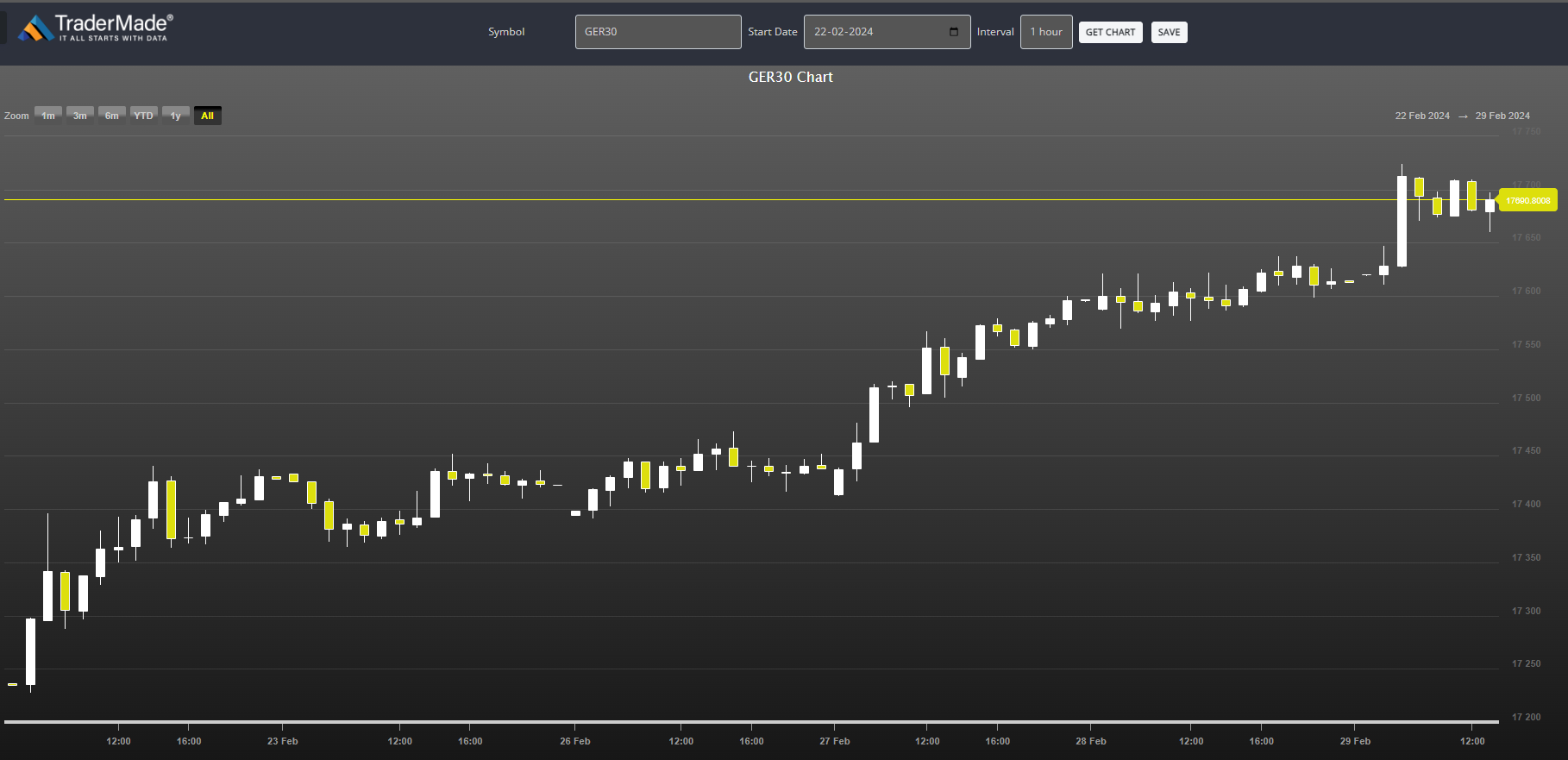
DAX Soars to New Highs, Defying German Recession Fears
London: 29 February 2024 (TraderMade): Germany's DAX index continued its record-breaking streak, reaching a new high on Thursday despite looming recession fears in the country. This seemingly contradictory trend has puzzled many, sparking discussions about the factors driving the DAX's rise and future trajectory.
Key Takeaways
- DAX Index: Reached a record high of 17,655 points on Thursday, 29 February 2024.
- German Economy: Faces a potential recession despite the DAX's strong performance.
- Reasons for DAX's Rise:
- DAX companies are primarily international and not solely reliant on the German economy.
- A weaker euro and lower interest rates could benefit DAX companies.
- Investor optimism surrounding the US economy and cooling inflation is positive for DAX companies.
- Future of DAX: DAX's future trajectory depends on factors like upcoming inflation data, central bank decisions, and corporate earnings reports.
Contrasting Trends: DAX Up, German Economy Down
DAX Hits Record High
The DAX index climbed to a record high of 17,655 points on Thursday, marking its sixth consecutive day of gains.
German Economy Faces Recession
Germany's economy may enter a technical recession, defined as two consecutive quarters of negative growth.
DAX (GER30) Rallies to Record Highs, Capping Upward Trend Over the Week
The German DAX index (GER30) witnessed a strong upward trajectory over the past week, culminating in a record high on Thursday, 29 February 2024. Let's delve into the details:
- Weekly Range: The DAX opened at 17,236.60 on 22 February and closed at 17,709.80 on 29 February, registering a weekly gain of 2.77%.
- Positive Momentum: The index exhibited a positive trend throughout the week, with each day closing higher than the previous day.
- Record-Breaking Close: The DAX reached a new record high of 17,723.80 on 29 February, surpassing the previous record set on the 27th.
- Intra-week Fluctuation: Despite the overall upward trend, the DAX experienced some intra-week volatility, with the daily range reaching a maximum of 195.50 points on 27 February.

Overall, the DAX experienced a remarkable week, exceeding expectations and defying concerns about a potential recession in the German economy. DAX's upcoming trajectory may rely on more than just past performance. Various factors can influence the DAX's trajectory in the coming weeks.
Behind the DAX's Rise: International Focus and Global Factors
DAX Companies Not Primarily German
Unlike the broader German economy, the DAX companies are primarily large international corporations, with most of their revenue coming from outside Germany.
Weak Euro and Lower Interest Rates Benefit DAX Companies
A potential euro weakening due to a stagnant German economy could benefit DAX companies by making their exports cheaper. Additionally, lower interest rates could boost corporate profits.
Investor Optimism on US Economy and Cooling Inflation
High consumer spending in the US and cooling inflation are positive signs for the global economy, potentially benefiting DAX companies.
While the DAX's performance may contradict the state of the German economy, it highlights the complex interplay of global economic factors and the specific characteristics of the companies within the index.
Factors Shaping the DAX's Future Trajectory
The DAX's performance may depend on several factors, including:
- German and US inflation data releases: Higher-than-expected inflation could dampen investor sentiment and impact the DAX.
- Central Bank commentary: Market participants will closely watch the European Central Bank (ECB) and the Federal Reserve (Fed) statements regarding future interest rate decisions.
- Corporate earnings reports: Upcoming earnings reports from DAX-listed companies could influence investor confidence.
The DAX's record-breaking performance presents a fascinating case study in market dynamics, prompting further analysis and observation to understand its future trajectory amidst a complex global economic landscape.


